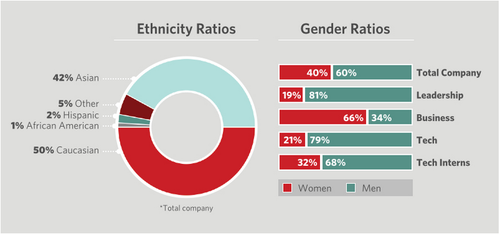Only 40 percent of Pinterest employees are women, even though the majority of the company’s users are female, according to a report released by Pinterest Thursday.
Pinterest’s ratio appears better than other tech companies that have released similar reports — only about 30 percent of employees at Facebook, Google and Twitter are female. But considering Pinterest’s users are overwhelmingly female — close to 70 percent — it’s somewhat shocking that they make up such a low percentage of the company’s total employees.

(Source: Pinterest)
Even though studies show women are four times more likely than men to use Pinterest and 97 percent of its Facebook fans are women, only 19 percent of leadership at Pinterest is female. It seems to me by failing to recruit and hire more women, the company likely is failing to gain female perspectives that could improve their user’s experiences.
When it comes to diversity, it seems Pinterest’s numbers are worse than the abysmal stats we’ve seen at other large tech companies. Only 2 percent of employees are Hispanic and 1 percent are black, compared to 3 and 2 percent, respectively, at Google. In 2013 AdWeek called Pinterest “the whitest social platform,” reporting that 18 percent of white Internet users had Pinterest accounts while only 8 percent of black and 10 percent of Hispanic Internet users went on the site. Given these numbers, that’s not a surprise.
With its post, Pinterest released the same trite statement we keep hearing from these tech companies.
“We’re not close to where we want to be, but we’re working on it,” wrote Tracy Chou, a software engineer and tech lead at Pinterest.
I’m getting sick of that response. When you look at tech positions alone, 21 percent of employees are female, which is better than numbers we’ve seen that hover around 10 percent at Twitter and 17 percent at Google. Although it seems Pinterest is trying to do better in its recruiting (32 percent of tech interns are female), it’s clear that significant change will take a long time.
But even more unsettling, although Pinterest outlines steps it’s taking to improve its gender gap, is that it appears the company hasn’t acted to rectify its poor diversity numbers. “While we’ve made some progress in diversifying gender at the company, we haven’t done as well in representing different ethnicities, and we’re focused on getting better,” Chou wrote.
But why not? With these numbers, it should be clear simply looking around Pinterest’s offices that diversity is a problem, and it’s already affecting who is using its products.
These tech company diversity reports keep coming, and that transparency is important because it sparks a conversation about these issues. But that doesn’t matter if nothing is done to rectify it.
Hopefully efforts to make these companies’ environments more inclusive will keep coming, too.
